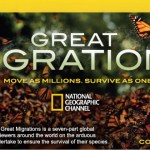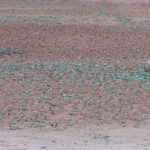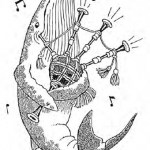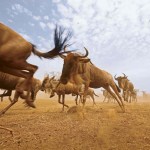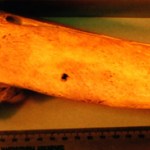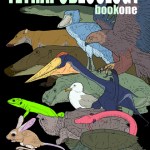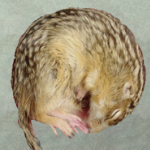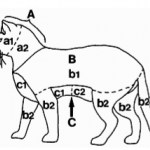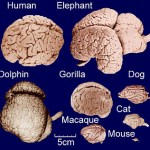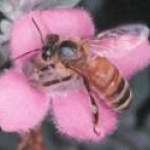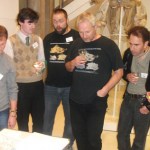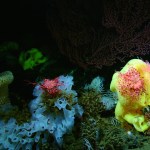Life Sciences
Last night, I was a guest of the National Geographic Channel at the historic Saban Theater in Beverly Hills for the United States premiere of Great Migrations, which airs internationally on Sunday, November 7.
Great Migrations is a 7-part TV "event," paired with an issue of National Geographic magazine, a set of kids' books, iPhone apps, and so forth. The mini-series, narrated by Alec Baldwin, focuses on the movements of animals across the earth in an effort to find food, to mate, and to survive. The first hour, which was screened for us, featured the migration of the monarch butterfly from…
Blair Wolf is an associate professor of biology at the University of New Mexico. Research in the Wolf lab focuses on the natural history and ecophysiology of desert animals. He agreed to blog with Dr. Dolittle on the topic of birds. Here are excerpts from their exchange.
Dr. Dolittle: What made you interested in studying the effects of Australian heat waves on bird populations?
Dr. Wolf: Australia has a very challenging environment, with a great expanse of hot desert and seems to be THE poster child for the bad things that are associated with climate warming. The continent has recently…
This is a repost, leading up to another post in the Evolution series. Watching Speciation Occur is the second in my Evolution series which started with The Curious Case of Dogs
We saw that the littlest differences can lead to dramatic variations when we looked at the wide variety in dogs. But despite their differences, all breeds of dogs are still the same species as each other and their ancestor. How do species split? What causes speciation? And what evidence do we have that speciation has ever occurred?
Critics of evolution often fall back on the maxim that no one has ever seen one species…
I'm going to be coming out with a new post in my Evolution series later this week, but in the meantime, for those of you haven't seen them, I'm reposting my first two Evolution posts, beginning with the one that started the series: The Curious Case of Dogs.
Man's best friend is much more than a household companion - for centuries, artificial selection in dogs has made them prime examples of the possibilities of evolution. A century and a half ago, Charles Darwin recognized how the incredibly diverse dogs supported his revolutionary theory in his famous book On The Origin Of Species. At the…
Blair Wolf is an associate professor of biology at the University of New Mexico. Research in the Wolf lab focuses on the natural history and ecophysiology of desert animals.
Preface: Dr. Blair Wolf's research discussed in a previous blog released August 13, 2010 on what causes the mass deaths of budgerigars (small birds in Australia) during heat waves sparked much discussion.
PHOTO: Budgerigars killed by a heat wave near a dried-up pond courtesy of Dr. Blair Wolf.
PHOTO: Budgerigars killed by a heat wave in Australia courtesy of Dr. Blair Wolf.
As a result of this discussion I decided to…
Time to continue in the Tet Zoo series on laryngeal diverticula (and other pouches, pockets and sacs). This time, we look at baleen whales, or mysticetes. Like the primates we looked at previously, mysticetes have enlarged laryngeal ventricles* that (mostly) meet along the ventral midline of the throat and form a single large laryngeal pouch or sac. The presence of a raphe along the sac's ventral midline seems to mark the line of fusion between the two ancestral, bilateral sacs. It's probably understandable that few of us are aware of the presence of inflatable laryngeal sacs in mysticetes…
On November 7th, National Geographic Channel airs the first of a seven-hour spectacle called Great Migrations. The series takes us on the paths of the world's most epic wanderers, from the small and delicate butterflies which travel thousands of miles from Mexico to Canada and back again to the yearly gauntlet of the massive herds of Africa. Here's the trailer:
Having gotten a sneak peak at the upcoming series, I can say with 100% certainty that has outdone my highest expectations, and, I believe, will be seen as one of the best nature mini-series of the year. In the new tradition of…
The recent, brief foray into Shoebill territory made now a sensible time to use a few other Shoebill-based images I have here in the Tet Zoo archives. That, and I haven't been able to finish anything more substantive due to other commitments. We begin with a lateral view of a skull I once photographed - sorry about the crazy colours, once again my fantastic photographic skills have done me proud (this image is a scan of a piece of special paper featuring the image... I think it's called a photograph [thanks to Victor for providing modified versions]).
Note how robust the jugal is (the thick…
Earlier this year (July) my children's book on Mesozoic reptiles - Dinosaurs Life Size - appeared in the shops. People seem to like it (yikes, even if some of the 'life sized' animals are scaled wrong). July also saw the publication of Dorling Kindersley's Know It All (Baines 2010): I didn't write the whole book, just the section on prehistoric animals. Today I'm pleased to announce that my third book for 2010 - Tetrapod Zoology Book One (Naish 2010) - is finally available.
Tetrapod Zoology Book One is a compilation of over 40 articles from Tet Zoo ver 1, and as such only includes articles…
Courtesy of Hannah CareyProgram Director, Physiological and Structural Systems
Punxsutawney Phil is best known for his ability to "forecast" whether there will be six more weeks of winter each year. Few people are aware, however, that groundhogs like Phil provide science with even more important information throughout the year. That's because groundhogs are hibernators.
Many animal species, like Phil, enviably spend the winter hibernating including bears, wood chucks, bats hedgehogs, lemurs and some squirrels. Hibernators curl their bodies into tight balls and slow their breathing and other…
Whether you're a dog, a cat, or a grad student who hasn't been home to shower for a few days, fleas are a major problem. They make skin itch. And NOTHING is worse than itchy skin.
But...
Do you know WHERE the fleas are? Where they like to hang out and guard their little flea eggs? Where's the best place for a flea to get a decent night's sleep, or a delicious snack? These are important questions. Lucky for us, Hsu, Hsu, and Wu of the Department of Entomology at National Taiwan University have the answers. And this paper, dear readers, is pure blogging GOLD.
Now, if you wanted to find out…
I've heard of "carrion beetles" but this is more like a "carry-on beetle":
Amanda and I were outside the cabin in Cass County, Minnesota last week, cutting pieces of plywood for sub flooring, and we saw this creature among the debris. At first I thought it was some kind of wasp covered with tiny spiders, but on further investigation it turned out to be a beetle covered with mites. When we first saw it, there were many more mites than in this photo, and they were virtually roiling on the insect's surface. It looked almost as though the insect was foaming.
We captured it for later…
The National Institutes of Health announced that by 2011 it will transfer almost two hundred chimpanzees from the Alamogordo Primate Facility in New Mexico to a lab in San Antonio, Texas, lab for use in invasive research. In 1995, the NIH announced a moratorium on the breeding of chimps in federally-supported labs, and as a result, scientists have developed alternative ways to investigate diseases. But there are still viruses, such as hepatitis C and HIV, that other species simply can't contract. This fact, some argue, makes it prudent to subject chimps to this sort of biomedical testing.…
The list is growing fast - check the submissions to date and get inspired to submit something of your own - an essay, a poem, a cartoon or original art. Continue to submit your best posts, and the best posts you read online. Especially those art/cartoon posts, and poems!
The Submission form is here so you can get started. Under the fold are entries so far, as well as buttons and the bookmarklet. The instructions for submitting are here.
You can buy the last four annual collections here. You can read Prefaces and Introductions to older editions here.
Interested in the origins of this project?…
Your humble narrator finds himself sick with a cold, so here's a post from the archives.
There is considerable research on how children interact with other children and with adults, and how child development can be influenced by those interactions. But research on children's interactions with non-human animals seem to be limited. Given how ubiquitous pets are in the homes of children (at least, in WEIRD cultures), it is somewhat surprising that there hasn't been more work on the way pet ownership might affect child development.
According to the US Humane Society:
There are approximately 77…
One theory of aging holds that accumulation of reactive oxygen species from aerobic metabolism damages nucleotides, proteins and lipids. Therefore, animals with a higher metabolism (poor mice) would be expected to produce more reactive oxygen species and age at a faster rate than animals with a slower metabolism (go sloths!). In a healthy individual, antioxidants help to protect from such increases in oxidative stress. However, this antioxidant capacity declines as we age.
You may be aware that bees transition from working around the hive to foraging at about 3 weeks of age. Foraging is much…
In the previous article on the 58th Symposium on Vertebrate Palaeontology and Comparative Anatomy (SVPCA), held in Cambridge, UK, I discussed some of the work that was presented on stem-tetrapods and sauropods. This time round, we look at more Mesozoic stuff - pterosaurs in particular - before getting on to Cenozoic mammals.
Steve Sweetman presented the first outing of a new miniscule maniraptoran theropod that he and I have been working on. When it gets published, nothing will ever be the same again (massive hyperbole fully intended: Steve's talk was more to do with salamanders, anurans…
Figure 1: Deep sea coral. Click to awesomely embiggen!
Another awesome exclusive video from our friends over at BBC Life Is. This month, the theme is corals, and the video (behind the fold, since it takes up a decent amount of bandwidth) features an interesting new attempt in Fiji to restore coral reefs.
They write:
Home to a quarter of the planet's marine life, wonderfully weird-looking, and of course brilliantly colourful, coral reefs are often hailed as one of the greatest of the ocean's wonders.
Despite being the home to so much amazing underwater life, almost unbelievably reefs only…
The Encyclopedia of Life is a cool tool which is a sort of wikification of taxonomy — it allows a large number of contributors to add descriptions of species with the goal of eventually documenting all 1.8 million known species in a single searchable source. Look at the page for my experimental animal, Danio rerio; lots of information in a standard format with links and references. Thumbs up!
However, there's a problem here: the sources. To organize that much data, a large mob of contributors are needed, and that means some fairly open policies to allow contributors have been instituted, and…
If I had to describe the mission, the point, the raison d'etre of the entire field of psychology in just one sentence, I would say: Psychology aims to determine the relative extents to which biology and experience determine cognition and behavior." And, as you might expect, there are widely differing schools of thought. Nativists emphasize genetics, biology, and innate mechanisms. By contrast, the empiricists insist that babies are born into the world with no a priori knowledge thereof, and just a powerful statistical associative learning mechanism by which they piece together their…
